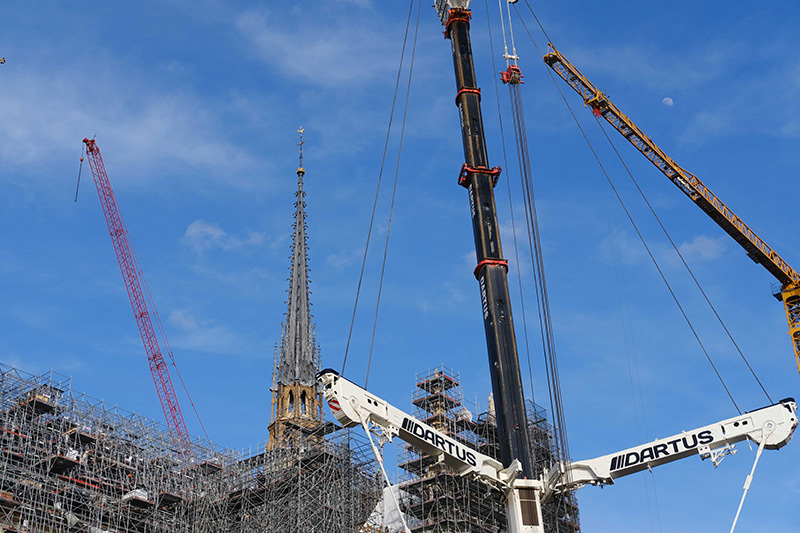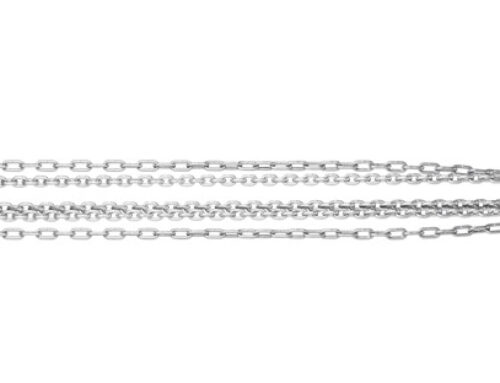The latest post by our sister company, American Scaffolding, put a spotlight on the reconstruction of the Notre Dame Cathedral and the intensive use of scaffolding during this ongoing project. While photos showed the Cathedral almost completely encased in scaffolding at times, it was impossible for us to overlook the presence of cranes and industrial rope on the worksite as well.

The Role of Industrial Wire Rope in Notre Dame’s Renovation
Original construction on Notre Dame Cathedral began in 1163. Nearly two hundred years later, in 1345, construction was completed. Today, in the third millennium, the process of renovating Notre Dame is a hybrid of the traditional methods of medieval times when it was originally built and modern techniques.
Medieval builders relied heavily on skilled craftsmanship and ingenuity to overcome challenges in construction. Master masons and carpenters developed techniques for shaping and fitting stone blocks, timber beams, and other materials in the creation of intricate architectural elements and structural components. In a recent NBC News feature, carpenter Hank Silver, owner of Ironwood Timberworks and a member of Carpenters without Borders, described recreating tools used in the 13th century toward the objective of replicating the Gothic-style wood framing of the original construction.
Still, when it comes to hoisting the framing and other heavy architectural elements, the use of modern-day cranes and industrial wire rope has emerged as vital to the renovation process in the continuing effort to rebuild and restore Notre Dame. These towering machines have played a crucial role in lifting materials, transporting equipment, and facilitating the intricate work required to revive the cathedral’s grandeur.
Although the restoration emphasizes the tradition and heritage in honor of the cathedral’s legacy, modern techniques and materials have been crucial to the project. Renovating a historic monument like Notre Dame presents unique challenges. Limited access, tight spaces, and the need to protect fragile artifacts require innovative solutions. In its original construction, workers used lifting techniques such as winches, treadmill cranes and rope and pulley systems.
While nowhere as sophisticated as modern cranes, medieval builders used various types of winches and cranes to lift heavy materials. These devices were often powered by human or animal labor, with workers turning large wooden wheels or using treadmills to operate the lifting mechanisms. For example, the treadmill crane was one of the most common types of cranes used in medieval construction. It featured a large wooden wheel with spokes, which workers would rotate to lift heavy loads attached to ropes or chains. Treadwheel cranes could be built on-site and were capable of lifting materials to considerable heights.
Rope and pulley systems were also integral to medieval construction, allowing workers to lift materials vertically and maneuver them into position. Multiple pulleys could be used to create mechanical advantage, enabling workers to lift heavier loads with less effort.
Although the methods used to hoist materials in medieval cathedral construction may seem rudimentary compared to modern technology, they were remarkably effective given the limitations of the time. The construction of cathedrals was a monumental undertaking that required not only physical labor but also meticulous planning, coordination, and craftsmanship. Today, engineers and construction teams have leveraged cutting-edge hoisting technology, including telescopic booms and remote-controlled systems, to overcome these obstacles while preserving the cathedral’s integrity.
Cranes and industrial wire rope have become indispensable tools in the restoration of Notre Dame. The ability to lift heavy materials to great heights enables workers to access every part of the cathedral safely and efficiently. From transporting stone blocks for masonry repairs to hoisting delicate sculptures for restoration, cranes provide the necessary versatility to tackle diverse challenges. The use of cranes in this endeavor serves as a visible reminder of the collaborative effort involved in rebuilding a cultural icon.
Ensuring safety of workers and the preservation of the structure itself are among primary concerns in renovating Notre Dame. Along with advanced safety features, cranes offer precision control, allowing operators to maneuver materials with accuracy, minimizing the risk of damage to delicate architectural elements.
These towering machines and massive cables represent not only the practical means to lift materials, but also are symbols of human ingenuity and determination. The restoration of Notre Dame is a testament to the resilience of historic monuments and the enduring spirit of preservation. The use of cranes and wire rope in the renovation of Notre Dame Cathedral underscores the intersection of tradition and modernity in architectural restoration.
From lifting heavy stones to delicately maneuvering priceless artifacts, cranes play a vital role in preserving the past while building for the future. As Notre Dame rises once again, it stands as a testament to the power of collaboration, innovation, and the enduring legacy of human achievement.





